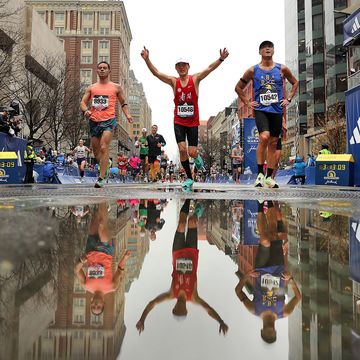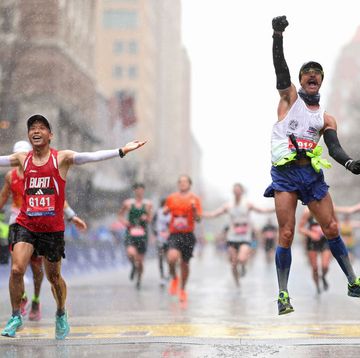This time of year, marathon inspiration is all around. Boston and London are in April, and the 2024 Paris Olympics are just around the corner.
Inspired? Great! If you are ready to start training for a marathon, we have everything you need: multiple marathon training plans, how to find the right race for you, food and fuel information, and even what to wear.
Whether you’re brand new to running or want to race a PR this fall, follow our advice and tips to train properly for a marathon. We know you’ll cross the finish line feeling eager to run another one soon.
Marathon Training Plans
We have Runner’s World+ Marathon Training Plans for every type of runner and every time goal. These are six of our most popular plans, and each is 16 weeks long. Runner’s World+ members get access to these ultimate marathon training guides (along with half marathon, 10K, and 5K plans... plus other great membership perks!). We even have a list of races from which you can choose!
- Beginner Marathon Training Plan
- Sub 4-hour Marathon Training Plan
- Sub 3:45 Marathon Training Plan
- Sub 3:30 Marathon Training Plan
- Sub 3:15 Marathon Training Plan
- Sub 3-hour Marathon Training Plan
How long should you train for a marathon?
Generally speaking, it takes between 12 and 20 weeks to train for a marathon, but most plans are 16 to 20-weeks. No matter your level of experience, you do need three to six months to be ready to run this distance. The race is a marathon, but so is the training!
All the training plans include different types of runs such as intervals, hill workouts, easy recovery runs, and a long run. A great plan makes sure you don’t overdo things, so you gradually build up your mileage to at least 20 miles, have recovery weeks built in, and plenty of rest and cross-training days. A solid marathon training plan also includes a prerace taper.
Sometimes, it helps to have a tune-up race on the calendar, too. If you’re thinking about a half marathon or 10K before you kick off marathon training, we have a training plan for that, too, and you can tackle those races this summer!
If you’ve picked a race for the fall, here’s when you need to start training:
Start a 16-Week Marathon Training Plan for Fall
May 12 → race dates: August 31/September 1
May 19 → race dates: September 7/ September 8
May 26 → race dates: September 14/September 15
June 2 → September 21/September 22
June 9 → September 28/September 29
June 16 → October 5/October 6
June 23 → October 12/October 13
June 30 → October 19/October 20
July 7 → October 26/October 27
July 14 → November 2/November 3
July 21 → November 9/November 10
July 28 →November 16/November 17
August 4 → November 23/November 24
August 11 → November 30/December 1
August 18 → December 7/December 8
August 25 → December 14/December 15
Which marathon should I run?
Marathons are scheduled throughout the year, so it’s easy to choose a race not just by date, but also things that will excite you, such as location (look for scenery like Mount Desert Island, Maine or history, like Philadelphia), plus, of course, your ability to travel, budget, and your goal (see more on that below).
We want to make it easy on you, so you can spend less time hunting down races and more time chasing PRs. Here’s some advice on choosing your next marathon:
- For beginners, try local races first. You can train on some of the exact roads you’ll cover on race day and avoid the disruptions of travel before and after the event.
- As you become more experienced, look for some mid-major races within a few hour radius. If you’re on the east coast, the Hartford Marathon in Connecticut is a great option. On the west coast? Try the California International Marathon in Sacramento. Ask for suggestions at your local running store or look at our extensive list of races.
- For more advanced runners, you might have a bucket list World Major Marathon in mind. Some fall marathons are Boston qualifiers.
Of course, these are only suggestions. The smartest way to plan your race schedule is to pick a fall race and then a spring race as your main goals. Then, you can fill in other races between them that fit into your training plan.
How do I determine my marathon goals?
Whether it’s your first or 50th marathon, each training cycle comes with a unique set of goals. Are you aiming to improve your health? Make it to the finish line? Trying to hit a time goal? Ask yourself those questions to help determine what you want to get out of your training and race day.
Finish times will vary depending on your level of experience, training cycle, and age. But you can tweak that goal by running a race during training, even a 5K, and using a pace chart to help you set your time goals.
What training plan should I use?
If you’re overwhelmed when you Google “marathon training plans,” you’re not alone.
Not only do you need a plan that gets you to the finish line, you need one that’s going to get you to the starting line feeling strong, healthy, and confident. That will look different to every single runner. Some people respond well to logging high mileage six days a week; others prefer lower-intensity plans that allow for more cross-training and fewer running days.
No matter what any other runner tells you about the plan they swear by, the best marathon training plan is one that works for you.
We have training plans for runners of all levels with a variety of goals—all of these plans include cross-training and rest days, which are key to preventing injuries from popping up during your training. Here’s what they are and a little bit about them:
Run your first marathon
You should be able to run at least 6 miles and be used to working out regularly at a moderate to hard effort when you kick off this 16-week plan. The plan includes four days of easy running, one long run, and two rest days.
Break 4 hours
This is for a consistent runner used to regularly working out four to five times a week. The 16-week plan starts off with a 10-mile week and builds up to a 48-mile week, with your long run maxing out at 22 miles. This runner will be looking to complete 26.2 at a 9:09 pace.
Break 3:45
For the consistent runner looking to complete 26.2 miles at 8:33 pace, this 16-week plan works up to a 22-mile long run and incorporates interval workouts and tempo paces throughout.
Break 3:30
For the consistent runner looking to complete 26.2 miles at 8:00 pace, this 16-week plan starts off with 32 miles a week and peaks at a 52-mile week. It also incorporates intervals, hills, and tempo workouts.
Break 3:15
Opt for this training plan if you’re a consistent runner who has completed at least one marathon and can already run at a hard effort for over an hour. Peaking at a 52-mile week, you’ll see Yasso 800s, intervals, hills, and tempo efforts at the end of long runs.
Break 3 hours
For the marathoner with race experience who is aiming to run 26.2 miles at 6:52 pace per mile, this is our most advanced plan. It peaks at 56 miles for the week and puts a focus on speedwork and long runs that incorporate your goal pace.
What if I miss training time or suffer an injury?
It’s important to stick to your training plan in order to run your best race. However, no one’s training is perfect. Niggles, injuries, or other unexpected life events (such as having to work late or care for a sick family member) can pop up, leading you to miss some training time. Take a deep breath. It’s okay!
No training plan is set in stone, and if you’re unable to complete a specific workout on the day your plan calls for it because something unexpected comes up, there’s nothing wrong with swapping it for a different day or simply taking a day off.
If you feel an injury coming on or getting worse, you should stop and take a rest day or cross-train, then reassess. It’s ultimately better to skip a few training days to allow your body to rest than to continue running and risk a more serious injury that leaves you unable to run your marathon.
What if my training feels too difficult?
Marathon training is no easy feat—it requires a ton of dedication to long runs, tempo runs, speed workouts, and cross-training. At times, this can feel overbearing and difficult. You should be uncomfortable to some degree; that’s normal when growing in anything. But your training shouldn’t feel impossible.
If your marathon training feels too hard, consider factors like rest days, pain levels, and your mindset. Are you taking proper time to recover from your efforts? Are you ignoring aching muscles? Are you in the right headspace before and during your workouts? Consider these questions and use them to help determine if you need to back off your runs or put more time into recovery efforts.
What should I eat during training?
Proper nutrition during marathon training is essential for fueling your runs and recovering well.
While what you eat before a run can vary depending on the specific workout you’re doing, carbs are key in providing your body with energy to complete your run. Good options include a banana, oatmeal, a bagel, a honey packet, or any combination of these foods, depending on how long or intense your workout is.
After the first hours of your run, aim to fuel with 30 grams of carbs every 30 to 45 minutes. This can include gels, gummies, or easy-to-eat whole foods. Your stomach can absorb up to 60 grams of carbs per hour when diluted with water so be sure to also hydrate properly along the way.
To help you recover faster, eat foods that restore your muscles, strengthen your bones, and reduce inflammation is important. This includes foods that contain protein, healthy fats, carbs, antioxidants, and certain vitamins and minerals (such as vitamin D, calcium, and electrolytes).
Experiment with fuel during your training—not on race day!—because everyone tolerates foods differently. Get a good sense of what works best so you don’t have any unexpected stomach issues on race day.
What shoes should I buy for my race?
Your running shoes are the most important piece of gear for training and race day. After all, if your kicks aren’t comfortable, your training and your marathon won’t be nearly as enjoyable.
Because everyone is different, there’s no singular best shoe that fits the bill for everyone. It’s important to find a shoe that fits you well and has features that meet your specific needs. For example, if you overpronate and have a wide foot, the shoe that works best for you might be different than someone who underpronates and has a narrow foot.
You also want to take into consideration the miles you put on your shoes. You generally can put about 300 to 500 miles on one pair of shoes before they wear out, so depending on how many miles you run during your training, you may want to invest in two pairs of shoes—one for training and one for race day. (Of course, some of the newer super training shoes might not last as long.)
Just remember: Don’t run your marathon in shoes you’ve never tried before—that’s a one way ticket to blisters or plantar fasciitis. You’ll want to know how they feel before completing 26.2 miles in them.
What should I wear to my race?
While everyone’s preferences are different, there are a few general rules to take into account when deciding what you should wear on race day. First and foremost, consider your race’s start time and the weather. If your race starts early in the morning, it may be cold out at first but warm up as the day goes on. If it’s supposed to rain, wearing water-proof or water-resistant items is a good idea.
With that said, layering is key. If you wear multiple layers, you can take clothes off as the weather or temperature changes. Just make sure to wear clothing you’re not attached to. Once you throw it off, you likely won’t get it back—most races pick up these leftover layers and donate them.
Regardless of the weather, consider certain fabrics that are soft, stretchy, and wick away sweat, like a polyester-spandex blend. Also—while not completely necessary—wearing a GPS watch helps keep track of your time and pace.
How should I recover after a marathon?
While everyone’s recovery time will look different, there are a few general strategies you can use to bounce back from your marathon. No one wants to limp around and avoid stairs in the days after a race.
Getting enough rest and sleep is necessary for your body to heal. But it’s still important to get your blood flowing by moving around (gently), as this will flush the lactic acid from your muscles. Try walking around, stretching, doing yoga, foam rolling, icing, or trying a tool like compression boots.
Don’t return to running too soon after your race—your body has been through a lot of stress while training for and running your marathon. But if you do, take it easy. Your body needs time to heal, so maybe throw some cross training in there before you start logging miles again.













